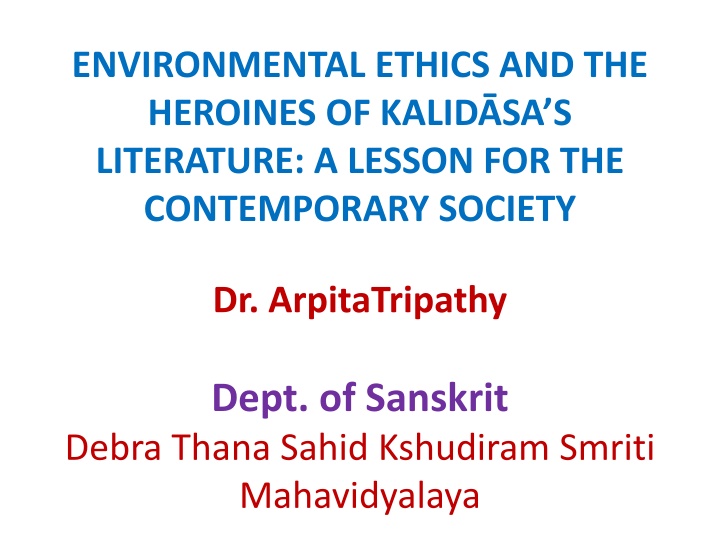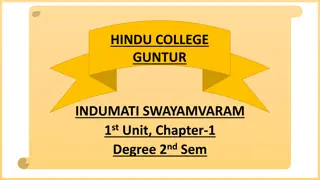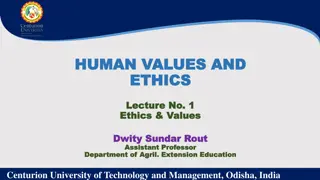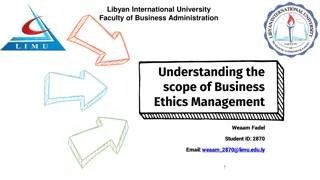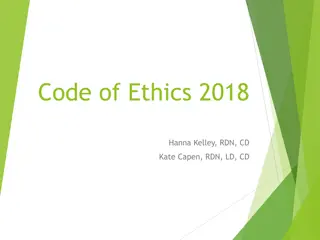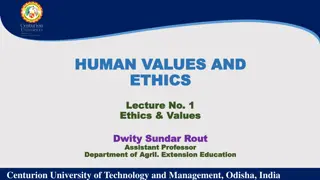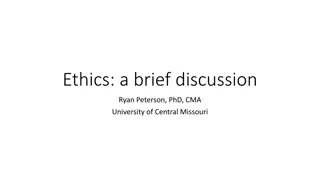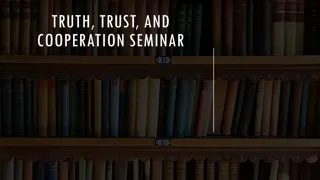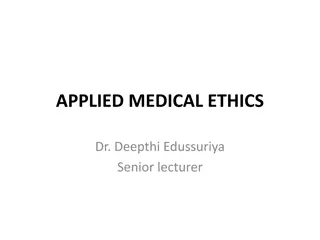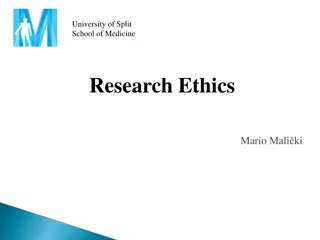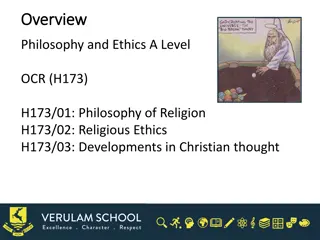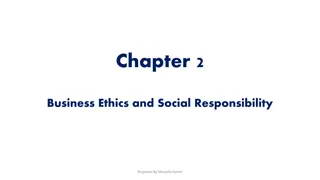Environmental Ethics in Kalidasa's Heroines
The heroines of Kalidasa's literature exemplify environmental ethics through their deep connection with nature, nurturing plants like their own children. They embody principles of care and responsibility towards the environment, offering a timeless lesson for contemporary society.
Download Presentation

Please find below an Image/Link to download the presentation.
The content on the website is provided AS IS for your information and personal use only. It may not be sold, licensed, or shared on other websites without obtaining consent from the author.If you encounter any issues during the download, it is possible that the publisher has removed the file from their server.
You are allowed to download the files provided on this website for personal or commercial use, subject to the condition that they are used lawfully. All files are the property of their respective owners.
The content on the website is provided AS IS for your information and personal use only. It may not be sold, licensed, or shared on other websites without obtaining consent from the author.
E N D
Presentation Transcript
ENVIRONMENTAL ETHICS AND THE HEROINES OF KALID SA S LITERATURE: A LESSON FOR THE CONTEMPORARY SOCIETY Dr. ArpitaTripathy Dept. of Sanskrit Debra Thana Sahid Kshudiram Smriti Mahavidyalaya
Environmental ethics is a branch of applied philosophy that studies the conceptual foundations of environmental values as well as more concrete issues surrounding societal attitudes, actions, and policies to protect and sustain biodiversity and ecological systems. Global warming, global climate change, deforestation, pollution are few of the issues from which nowadays our planet is suffering. With the help of environmental ethics one can ensure that s/he is doing his/her part to keep the environment safe and protected.
The heroines of Klidsas literature have been portrayed as the daughters of nature. Not only that the great poet K lid sa depicts the principle of environmental ethics through the activities of his heroines. P rvat (Kum rasambhavam), akuntal (Abhij na kuntalam), Yak apatn (Meghad dam), Indumat (Raghuva am), M lavik (M lavik gnimitram) almost all heroines of K lid sa nurtured plants and trees like their own children.
They had so much affection for their plants that the commentator of Meghad tam, PurnaSaraswati says, priyay natutad yacher janena .b tsyaly tsvayame baparipo ita. The heroines of K lid sa s literature who are either queens or princesses never left their beloved plants to servants or maids for nursing or care. They always took utmost care of their plants themselves.
akuntal never took a single drop of water without watering the plants of the hermitage. Perhaps watering the trees was an obvious duty of the ladies who lived in the hermitage at that time. Although it was their obvious duty they did it eagerly. So akuntal said, if Ka va had not ordered her to water the trees she must have done it.
Actually in the garden of the hermitage there was a trench or basin at the root of the trees for holding water when poured. The girls had to pour that trench which was really a tough job for them. But they did it regularly because they knew the young trees, the grown up trees could not be able to become full grown trees without being watered.
The hermit- daughters quitted the place immediately after the watering was over, because they wanted to inspire confidence in the birds who were accustomed to drink water from the basins round the roots of the trees. The girls were aware about that, the birds and other animals who came to drink water from the trench should not be disturbed.
The picture is the same in the Kumrasambhavam. P rvat never slacked in her care and she personally reared up the saplings with water. In the Kum rasambhabamit is said that, atandrit s swayamebab k ak ngha astanaprasraba ai rbyabardhayat.
She had motherly affection for those saplings which K rtikeya would not be able to set aside. P rvat , akuntal and other heroines of K lidasa always felt motherly or sisterly affection towards the trees, saplings, creepers and animals. Not only they look after to the young trees they had the same feelings for the matured trees also. akuntal named a creeper who was like her own beloved sister as Vanajyotsn .
She used to always said if she forget this jasmine creeper who is a self-selecting bride of a mango tree she will forget her own self. In the garden there was a tree whose leaves set in motion by the winds. But akuntal said the tree beckoned her nearer with his fingers. Kale presumes that the matching of a tree with some creeper and even celebration of their wedding is a favorite theme with the Sanskrit poets. It should be observed that through this celebration or mock marriage akuntal and other heroines of K lid sa s literature treated these plants, trees, creepers as human beings.
They were aware about the right timings of blossom. If the trees do not bloom at proper time they became worried and took special care like Dohadak rya (fulfill the desires during pregnancy). In the third act of M lavik gnimitram, M lavik went to the garden to strike the A oka tree which was eagerly waiting for the kick of a fair lady to blossom fully. It is one of the essential rituals of Dohadak rya . About Dohadak rya, M.R. Kale says2 .a craving for something felt by plants(according to poetic ideas). It is described kind of preparation or recipe which enables plants to put forth flowers or fruits even out of their season.
It should be noted, Jagadish C. Bose proved that plants have life and they also suffer, sleep and get excited. If so, then the special care and touch for a tree are justified. In the ancient times it was believed that a flowerless A oka tree blossoms in the kick of a beautiful lady. It is said: str spar tpriyangurbikasatibakula dhuga asek t/ p d gh t da okastilakakurabakoub k a lingan bhy m 3
The animal kingdom is an integral and most important part of eco-system. K lid sa has provided numbers of moral lessons through the behavior of the heroines of his literature towards the animals. akuntal reared a baby deer with handful rice after the death of his mother. When the deer became wounded with the sharp points of ku a grass akuntal applied the healing oil of Ingud . Love and kindness towards dumb animals is an inherent character of K lid sa s works.
The heroines of Klidsas literature are not only from nature they are created as the protectors of nature and wild lives. They knew how to behave with their co- inhabitants of earth. They always treated the creepers, trees and animals as their own family members. They took them not only as the co- inhabitants of the earth but also their soul mates. By celebrating mock marriage, Dohadak rya of plants (fulfillment of desires during pregnancy / baby shower) it seems that they satisfied their own future desires.
At the time of departure akuntal was seeking permission from the co-inhabitants of forest. She did not drink water first before the plants were watered; she never plucked the leaves or flowers of the trees although she loved to wear ornaments of flowers and leaves. When the trees first put forth their blossoms it was a festivity to her. These co- inhabitants and friends of forest expressed their heavy grief in this way:
The female deer stop chewing grass, the peacocks have given up their dancing and the creepers with their yellow leaves falling off, seem, as if to be shedding tears. At the time of departure akuntal did not forget about the pregnant deer who was roaming in the vicinity of the hut and requested Kanva to send the message of her safe delivery.
Klidsa always wanted to give the massage that animals, plants also have love or passion for human beings. If one gives love or care to them they returned it by anyway. Nowadays people are insensitive and robotic. So they do not feel the love of mother earth which comes through fresh air, clean sky, clear water, sweet music of birds etc.
To Klidsa animals are other beloved co-habitants of earth who have the same right to be treated or cared like human beings. In the Raghuva a, Nandin (the cow) was attacked by a lion named Kumbhodara. Kumbhodara was placed as a protector of a yonder Devad ru tree. This tree was adopted as a son of iva P rvat and P rvat nourished it by watering from gold pitchers. She had so much affection that K lid sa says, the tree knew the taste of the payas (milk) of Skanda s mother issuing out from her breasts.
One day a wild elephant destroyed its bark and Prvat grieved for it as if Skanda was wounded by the missiles of the demons. From that day Kumbhodara was placed in the cave of the mountain to scare the wild elephants and protect the tree. iva fixed that who will come to this cave this lion can take it as his meal. At the death of Indumat when Aja was lamenting in distress he truly said it was heart breaking task for him to offer a garland of A oka flowers for the funeral of Indumat .
Aoka tree also mourned by shedding tears in the form of flowers because the tree was supposed to remember its Dohadak rya (fulfillment of desires) which was done by Indumat by giving the special touch of her left foot. K lid sais well known as nature s poet and the heroines of his writings are formed with the beauty of nature. But simultaneously he shows that from birth to death the heroines are attached with nature by every activity of their day to day work.
At the time of describing the surroundings of his home Yak a describes: There is a pleasure mountain and on it there are a red A oka tree with its waving foliage and a beautiful Ke ara close to the bower of the M dhav creepers (atimuktalat ) having a hedge of the Kurubaka plants. The A oka (Red A oka) is said to put forth flowers when kicked with her left foot by Yak apatn . K lid sa uses the term dohodachadman which means although the trees are able to bloom intentionally as they want the touch of Yak apatn s left foot.
The heroines of his literature always seen to learn something from nature. The royal swans taught P rvat how to step beautifully because they themselves learn from her in return how to utter notes sweet like the jingle of her foot ornaments. They also tried to learn the sweet voice of cuckoos, tremulous glances from deer, amorous sports from creepers. Every performing art has its origin in nature. It is important to note that Saptasvaras , the basic notes of music, evolved from the cries of different animals and birds.
The Indian musicians described that peacocks call in sa gama (s ), C taka birds call as well as bulls and cows low in i abha (Re), goats and sheep bleat in Gandh ra (G ), Krounca birds sing and lions roar in Madhyam (M ), frogs croak and horses neigh in Dhaivata (Dh ), elephants trumpet in Nishada (Ni). Living in nature s lap, the primitive man must have watched how snakes danced spreading their hoods, and how peacocks danced spreading their colorful plumes. Then he must have tried to imitate them. These initial attempts of imitation of sights of nature slowly evolved into different forms of dance. People made different musical instruments, having been inspired by the sounds and sights of nature also.
Actually still nature is the source of our every need and people are collecting everything directly or indirectly from it but they forget to take care of the source. As a result, natural sources are decreasing, the qualities of corns, fruits, vegetables, the nutrition of natural foods are vanishing. Men are nowadays replacing the lack of vitamins, proteins and nutrition artificially. They made lot of artificial nutritious foods, multivitamins, medicines to fill up the lack of nutrition in the body.
Not only that nowadays people are busy to make buildings, bridges, towns, artificial gardens. To beautify their roads with artificial things they are cutting the natural trees. They like to decorate their home with artificial flowers. They forget about the mother earth; they forget about the co inhabitants of the earth. They like to see the fishes in aquarium, they like to keep the birds in cages, they like to confine animals in zoos and forget to show the kindness which they deserve.
As a result, the eco system is slowly breaking down. People are digging their own graves. They should learn from K lid sa s literature how to live in harmony with nature, how to take care of plants, how to be sympathetic towards animals etc. If the humans do not take lesson today, soon they will face the destruction of their civilization. The world s most intelligent animals will soon become extinct.
